English for Academic Purposes (EAP) Online Portfolio
VerifiedAdded on 2023/01/05
|9
|3002
|94
Portfolio
AI Summary
This EAP portfolio showcases a student's work in an English for Academic Purposes course, focusing on academic writing skills and comparing higher education systems. The portfolio includes self-evaluation checklists, outlines, summaries, and paragraph structure exercises. The core of the portfolio is an essay that compares and contrasts the higher education systems of England and Finland in terms of funding and quality, culminating in a conclusion about which system is preferable. The essay delves into the funding sources, quality assurance mechanisms, and overall structures of both systems, drawing on various academic sources. The portfolio demonstrates the student's ability to analyze, synthesize information, and present arguments in a clear and structured manner, highlighting key aspects of academic writing such as research, outlining, summarizing, and paragraph construction. This assignment is a valuable resource for students seeking examples of academic writing and insights into higher education systems.
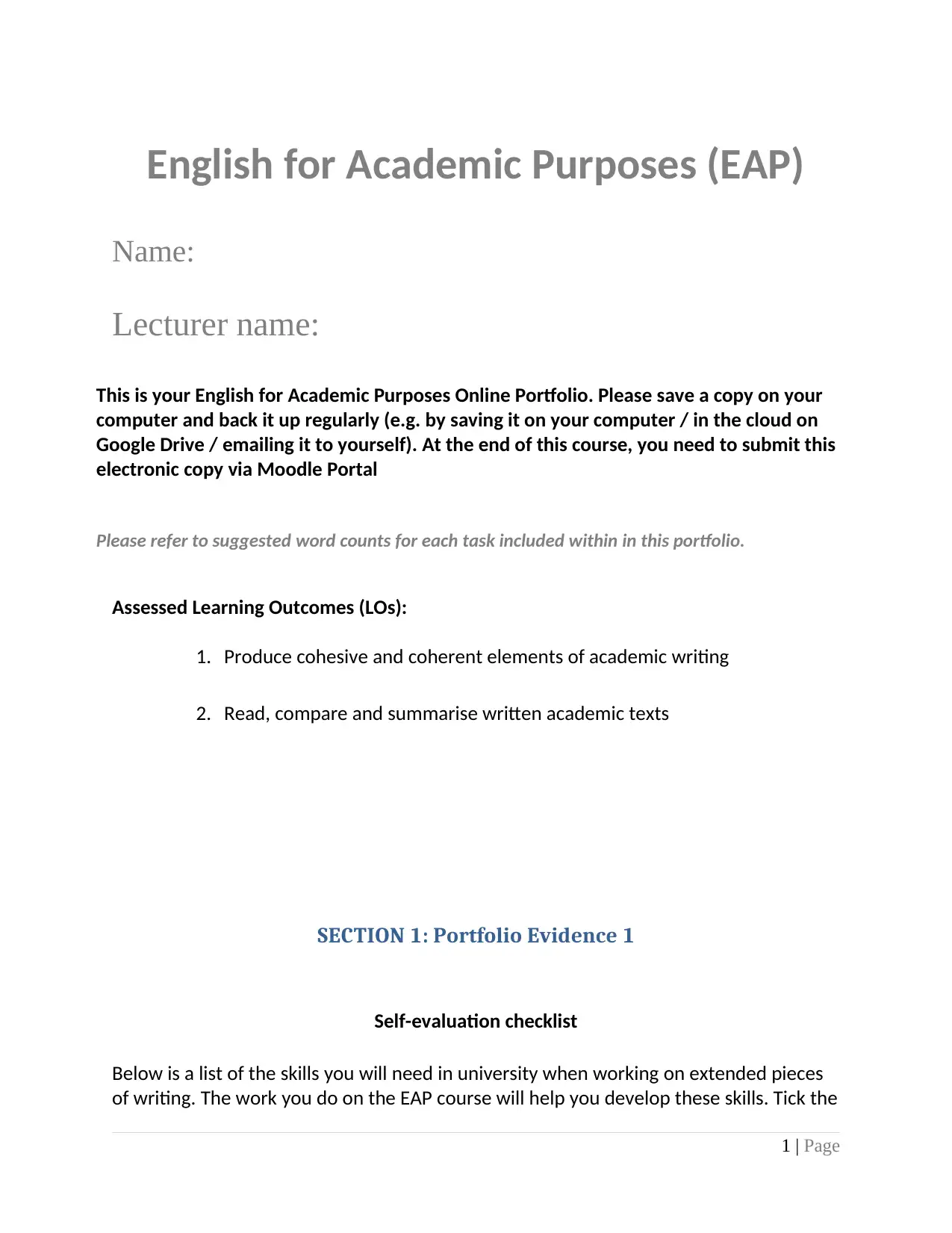
English for Academic Purposes (EAP)
Name:
Lecturer name:
This is your English for Academic Purposes Online Portfolio. Please save a copy on your
computer and back it up regularly (e.g. by saving it on your computer / in the cloud on
Google Drive / emailing it to yourself). At the end of this course, you need to submit this
electronic copy via Moodle Portal
Please refer to suggested word counts for each task included within in this portfolio.
Assessed Learning Outcomes (LOs):
1. Produce cohesive and coherent elements of academic writing
2. Read, compare and summarise written academic texts
SECTION 1: Portfolio Evidence 1
Self-evaluation checklist
Below is a list of the skills you will need in university when working on extended pieces
of writing. The work you do on the EAP course will help you develop these skills. Tick the
1 | Page
Name:
Lecturer name:
This is your English for Academic Purposes Online Portfolio. Please save a copy on your
computer and back it up regularly (e.g. by saving it on your computer / in the cloud on
Google Drive / emailing it to yourself). At the end of this course, you need to submit this
electronic copy via Moodle Portal
Please refer to suggested word counts for each task included within in this portfolio.
Assessed Learning Outcomes (LOs):
1. Produce cohesive and coherent elements of academic writing
2. Read, compare and summarise written academic texts
SECTION 1: Portfolio Evidence 1
Self-evaluation checklist
Below is a list of the skills you will need in university when working on extended pieces
of writing. The work you do on the EAP course will help you develop these skills. Tick the
1 | Page
Paraphrase This Document
Need a fresh take? Get an instant paraphrase of this document with our AI Paraphraser

appropriate box for each skill, according to how well you think you can do this at the
beginning of this course. Look again at the checklist throughout the course in order to
identify areas for independent study.
Skills Do not
know about
this
Find this
difficult/
can’t do this
Can partially
do this
Can do this well
Looking for information
Identify which books/journals/websites to use ☐ ☐ ☐ ☐
Select relevant parts of a text ☐ ☐ ☐ ☐
Using sources
Acknowledge sources of information ☐ ☐ ☐ ☐
Avoid plagiarism ☐ ☐ ☐ ☐
Planning/ writing
Brainstorm ideas ☐ ☐ ☐ ☐
Plan written work ☐ ☐ ☐ ☐
Link ideas effectively ☐ ☐ ☐ ☐
Paraphrase & summarise ideas ☐ ☐ ☐ ☐
Write an introduction ☐ ☐ ☐ ☐
Write a conclusion ☐ ☐ ☐ ☐
Personal study
Work independently ☐ ☐ ☐ ☐
Manage my time ☐ ☐ ☐ ☐
Oral presentation
Discuss written work in a tutorial ☐ ☐ ☐ ☐
IT
Access the internet ☐ ☐ ☐ ☐
Use search engines ☐ ☐ ☐ ☐
Create word documents ☐ ☐ ☐ ☐
2 | Page
beginning of this course. Look again at the checklist throughout the course in order to
identify areas for independent study.
Skills Do not
know about
this
Find this
difficult/
can’t do this
Can partially
do this
Can do this well
Looking for information
Identify which books/journals/websites to use ☐ ☐ ☐ ☐
Select relevant parts of a text ☐ ☐ ☐ ☐
Using sources
Acknowledge sources of information ☐ ☐ ☐ ☐
Avoid plagiarism ☐ ☐ ☐ ☐
Planning/ writing
Brainstorm ideas ☐ ☐ ☐ ☐
Plan written work ☐ ☐ ☐ ☐
Link ideas effectively ☐ ☐ ☐ ☐
Paraphrase & summarise ideas ☐ ☐ ☐ ☐
Write an introduction ☐ ☐ ☐ ☐
Write a conclusion ☐ ☐ ☐ ☐
Personal study
Work independently ☐ ☐ ☐ ☐
Manage my time ☐ ☐ ☐ ☐
Oral presentation
Discuss written work in a tutorial ☐ ☐ ☐ ☐
IT
Access the internet ☐ ☐ ☐ ☐
Use search engines ☐ ☐ ☐ ☐
Create word documents ☐ ☐ ☐ ☐
2 | Page
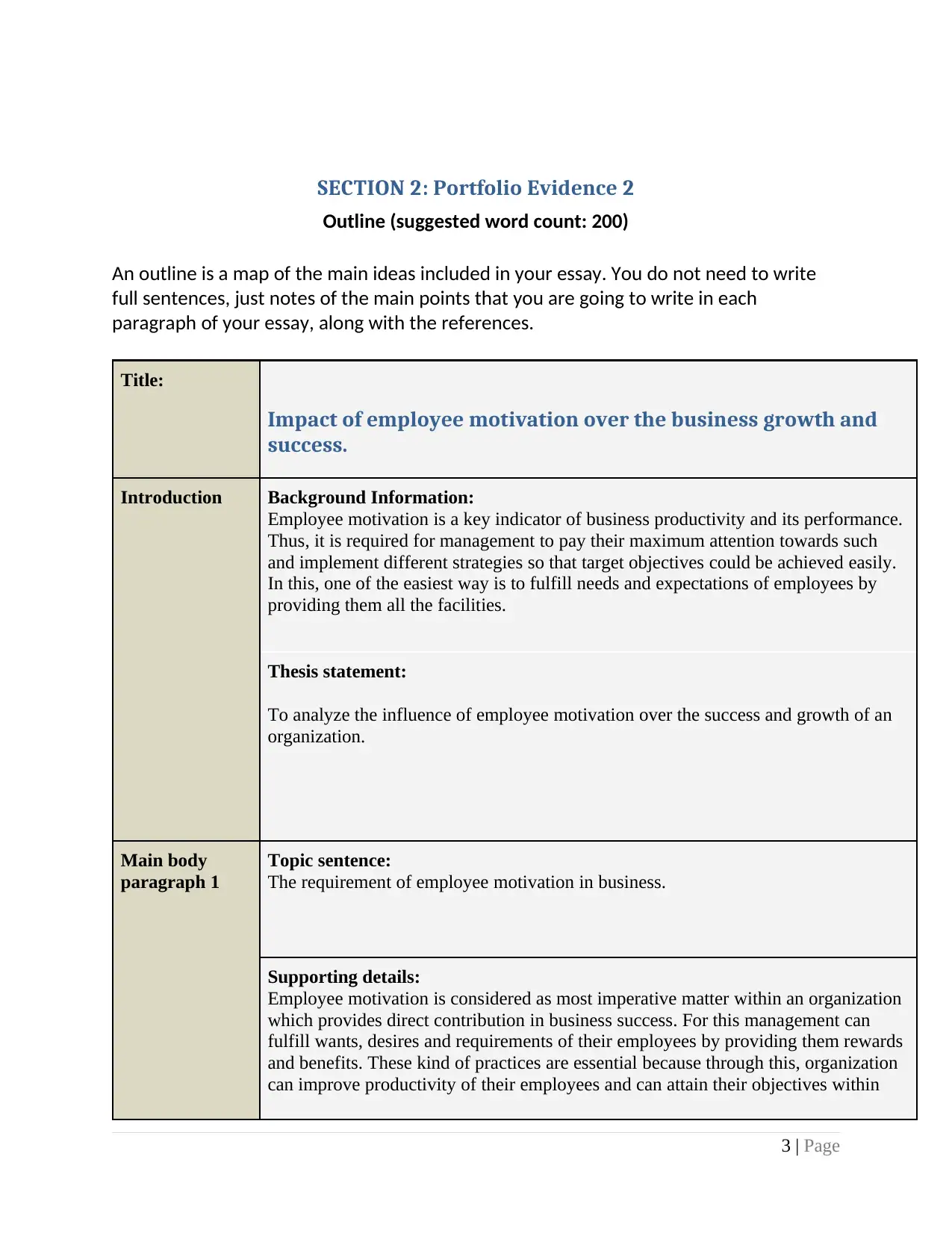
SECTION 2: Portfolio Evidence 2
Outline (suggested word count: 200)
An outline is a map of the main ideas included in your essay. You do not need to write
full sentences, just notes of the main points that you are going to write in each
paragraph of your essay, along with the references.
Title:
Impact of employee motivation over the business growth and
success.
Introduction Background Information:
Employee motivation is a key indicator of business productivity and its performance.
Thus, it is required for management to pay their maximum attention towards such
and implement different strategies so that target objectives could be achieved easily.
In this, one of the easiest way is to fulfill needs and expectations of employees by
providing them all the facilities.
Thesis statement:
To analyze the influence of employee motivation over the success and growth of an
organization.
Main body
paragraph 1
Topic sentence:
The requirement of employee motivation in business.
Supporting details:
Employee motivation is considered as most imperative matter within an organization
which provides direct contribution in business success. For this management can
fulfill wants, desires and requirements of their employees by providing them rewards
and benefits. These kind of practices are essential because through this, organization
can improve productivity of their employees and can attain their objectives within
3 | Page
Outline (suggested word count: 200)
An outline is a map of the main ideas included in your essay. You do not need to write
full sentences, just notes of the main points that you are going to write in each
paragraph of your essay, along with the references.
Title:
Impact of employee motivation over the business growth and
success.
Introduction Background Information:
Employee motivation is a key indicator of business productivity and its performance.
Thus, it is required for management to pay their maximum attention towards such
and implement different strategies so that target objectives could be achieved easily.
In this, one of the easiest way is to fulfill needs and expectations of employees by
providing them all the facilities.
Thesis statement:
To analyze the influence of employee motivation over the success and growth of an
organization.
Main body
paragraph 1
Topic sentence:
The requirement of employee motivation in business.
Supporting details:
Employee motivation is considered as most imperative matter within an organization
which provides direct contribution in business success. For this management can
fulfill wants, desires and requirements of their employees by providing them rewards
and benefits. These kind of practices are essential because through this, organization
can improve productivity of their employees and can attain their objectives within
3 | Page
⊘ This is a preview!⊘
Do you want full access?
Subscribe today to unlock all pages.

Trusted by 1+ million students worldwide
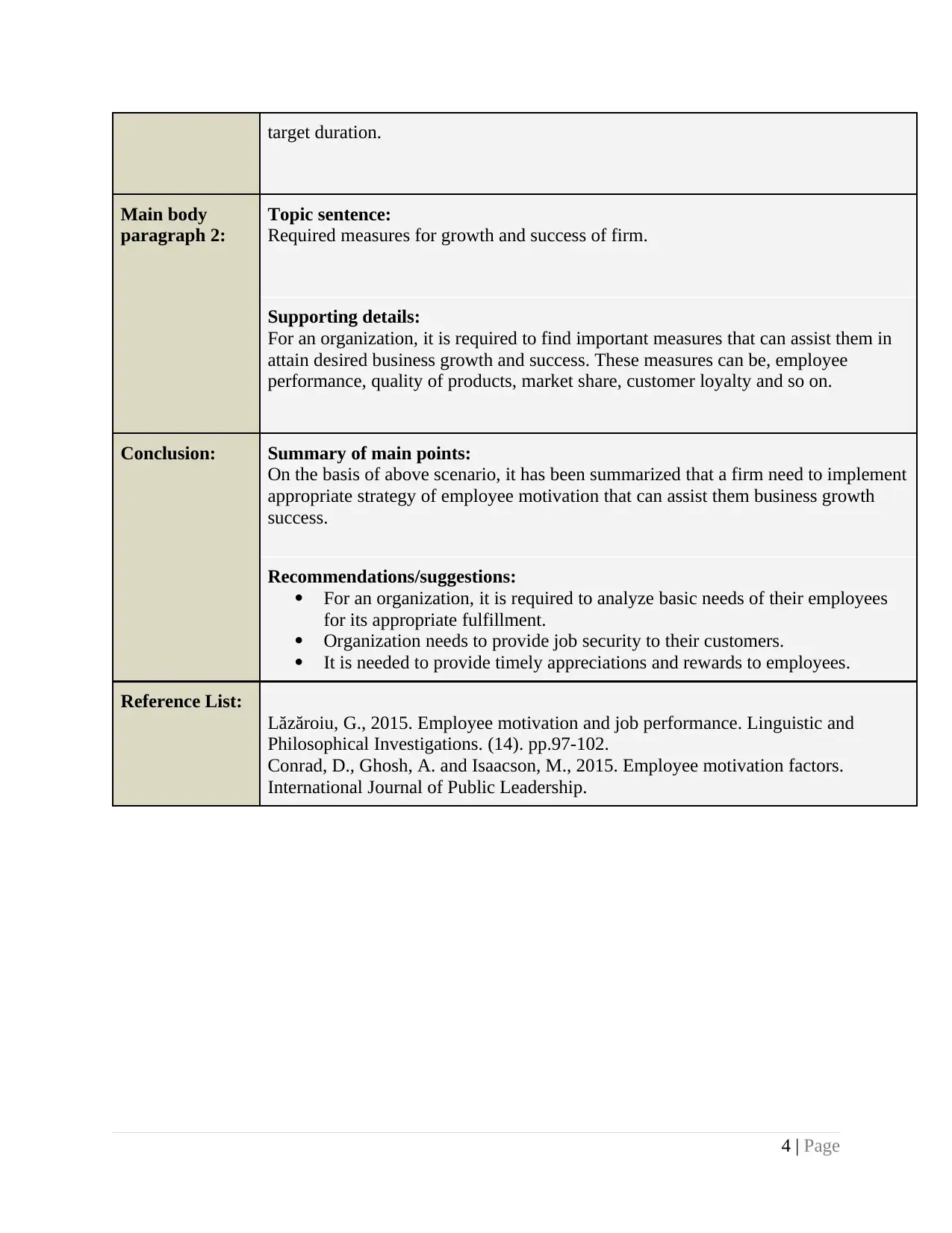
target duration.
Main body
paragraph 2:
Topic sentence:
Required measures for growth and success of firm.
Supporting details:
For an organization, it is required to find important measures that can assist them in
attain desired business growth and success. These measures can be, employee
performance, quality of products, market share, customer loyalty and so on.
Conclusion: Summary of main points:
On the basis of above scenario, it has been summarized that a firm need to implement
appropriate strategy of employee motivation that can assist them business growth
success.
Recommendations/suggestions:
For an organization, it is required to analyze basic needs of their employees
for its appropriate fulfillment.
Organization needs to provide job security to their customers.
It is needed to provide timely appreciations and rewards to employees.
Reference List:
Lăzăroiu, G., 2015. Employee motivation and job performance. Linguistic and
Philosophical Investigations. (14). pp.97-102.
Conrad, D., Ghosh, A. and Isaacson, M., 2015. Employee motivation factors.
International Journal of Public Leadership.
4 | Page
Main body
paragraph 2:
Topic sentence:
Required measures for growth and success of firm.
Supporting details:
For an organization, it is required to find important measures that can assist them in
attain desired business growth and success. These measures can be, employee
performance, quality of products, market share, customer loyalty and so on.
Conclusion: Summary of main points:
On the basis of above scenario, it has been summarized that a firm need to implement
appropriate strategy of employee motivation that can assist them business growth
success.
Recommendations/suggestions:
For an organization, it is required to analyze basic needs of their employees
for its appropriate fulfillment.
Organization needs to provide job security to their customers.
It is needed to provide timely appreciations and rewards to employees.
Reference List:
Lăzăroiu, G., 2015. Employee motivation and job performance. Linguistic and
Philosophical Investigations. (14). pp.97-102.
Conrad, D., Ghosh, A. and Isaacson, M., 2015. Employee motivation factors.
International Journal of Public Leadership.
4 | Page
Paraphrase This Document
Need a fresh take? Get an instant paraphrase of this document with our AI Paraphraser

SECTION 3: Portfolio Evidence 3
Summarising (suggested word count, 100 including notes)
Question: What are the similarities and differences between universities in England
and Finland in relation to tuition fees?
Notes (Text 1): Notes (Text 2):
University in Finland:
University of Turku
Aalto University
Tampere University
University of Oulu
LUT University
Universities in England
University of Edinburgh
King's College London
University of Manchester
University of Oxford
UCL or University College of London
What are the similarities and differences between universities in England and Finland in
relation to tuition fees?
Difference:
In England, there is strong hierarchy in education system whereas in Finland, no strong
hierarchy followed by schools.
The study in England is majorly focuses on test preparation as well as lifelong things but in
Finland study is all about lifelong things and success.
Similarity:
Main objective of education system in both England and Finland is to improve provide
higher and success education for their future career growth.
5 | Page
Summarising (suggested word count, 100 including notes)
Question: What are the similarities and differences between universities in England
and Finland in relation to tuition fees?
Notes (Text 1): Notes (Text 2):
University in Finland:
University of Turku
Aalto University
Tampere University
University of Oulu
LUT University
Universities in England
University of Edinburgh
King's College London
University of Manchester
University of Oxford
UCL or University College of London
What are the similarities and differences between universities in England and Finland in
relation to tuition fees?
Difference:
In England, there is strong hierarchy in education system whereas in Finland, no strong
hierarchy followed by schools.
The study in England is majorly focuses on test preparation as well as lifelong things but in
Finland study is all about lifelong things and success.
Similarity:
Main objective of education system in both England and Finland is to improve provide
higher and success education for their future career growth.
5 | Page
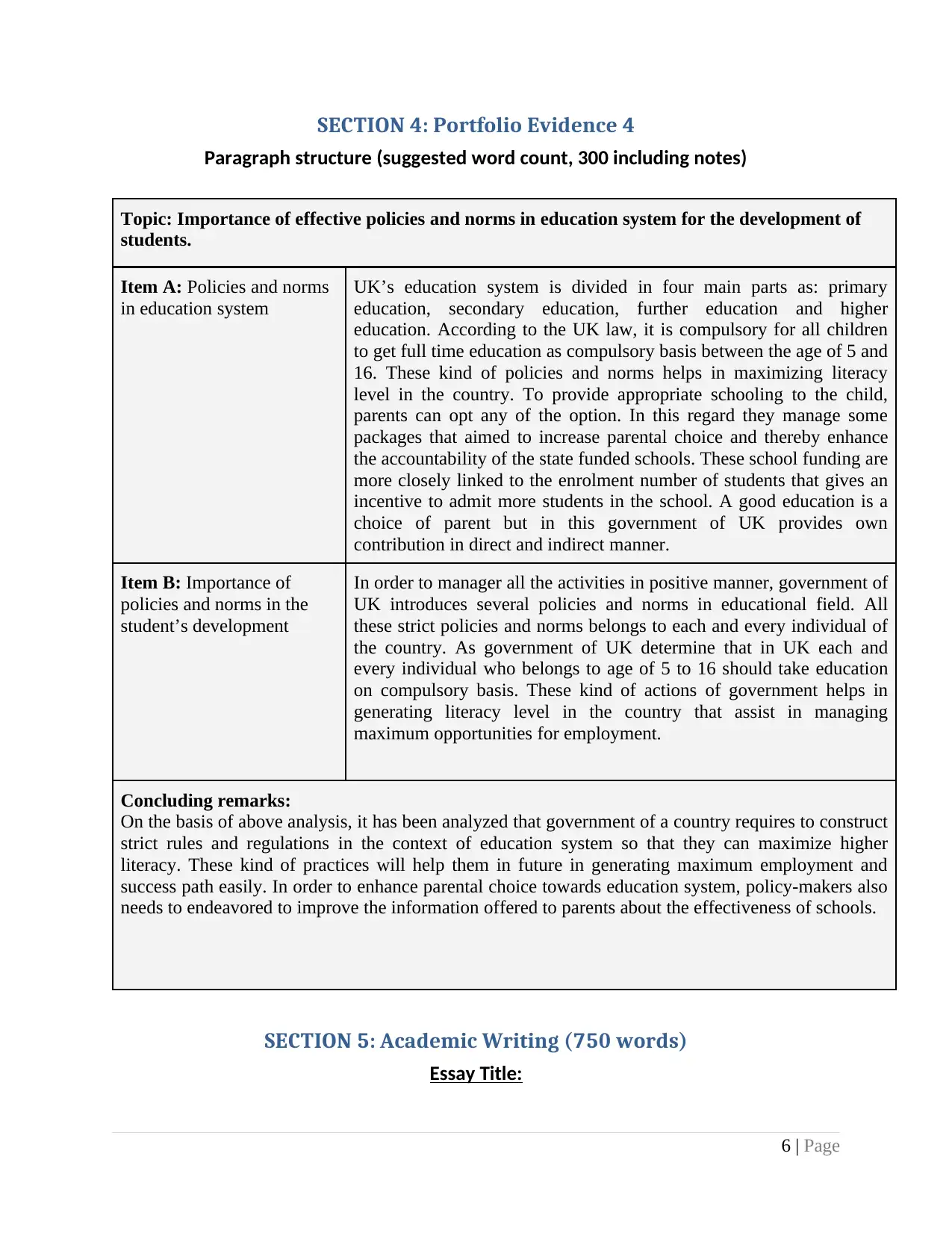
SECTION 4: Portfolio Evidence 4
Paragraph structure (suggested word count, 300 including notes)
Topic: Importance of effective policies and norms in education system for the development of
students.
Item A: Policies and norms
in education system
UK’s education system is divided in four main parts as: primary
education, secondary education, further education and higher
education. According to the UK law, it is compulsory for all children
to get full time education as compulsory basis between the age of 5 and
16. These kind of policies and norms helps in maximizing literacy
level in the country. To provide appropriate schooling to the child,
parents can opt any of the option. In this regard they manage some
packages that aimed to increase parental choice and thereby enhance
the accountability of the state funded schools. These school funding are
more closely linked to the enrolment number of students that gives an
incentive to admit more students in the school. A good education is a
choice of parent but in this government of UK provides own
contribution in direct and indirect manner.
Item B: Importance of
policies and norms in the
student’s development
In order to manager all the activities in positive manner, government of
UK introduces several policies and norms in educational field. All
these strict policies and norms belongs to each and every individual of
the country. As government of UK determine that in UK each and
every individual who belongs to age of 5 to 16 should take education
on compulsory basis. These kind of actions of government helps in
generating literacy level in the country that assist in managing
maximum opportunities for employment.
Concluding remarks:
On the basis of above analysis, it has been analyzed that government of a country requires to construct
strict rules and regulations in the context of education system so that they can maximize higher
literacy. These kind of practices will help them in future in generating maximum employment and
success path easily. In order to enhance parental choice towards education system, policy-makers also
needs to endeavored to improve the information offered to parents about the effectiveness of schools.
SECTION 5: Academic Writing (750 words)
Essay Title:
6 | Page
Paragraph structure (suggested word count, 300 including notes)
Topic: Importance of effective policies and norms in education system for the development of
students.
Item A: Policies and norms
in education system
UK’s education system is divided in four main parts as: primary
education, secondary education, further education and higher
education. According to the UK law, it is compulsory for all children
to get full time education as compulsory basis between the age of 5 and
16. These kind of policies and norms helps in maximizing literacy
level in the country. To provide appropriate schooling to the child,
parents can opt any of the option. In this regard they manage some
packages that aimed to increase parental choice and thereby enhance
the accountability of the state funded schools. These school funding are
more closely linked to the enrolment number of students that gives an
incentive to admit more students in the school. A good education is a
choice of parent but in this government of UK provides own
contribution in direct and indirect manner.
Item B: Importance of
policies and norms in the
student’s development
In order to manager all the activities in positive manner, government of
UK introduces several policies and norms in educational field. All
these strict policies and norms belongs to each and every individual of
the country. As government of UK determine that in UK each and
every individual who belongs to age of 5 to 16 should take education
on compulsory basis. These kind of actions of government helps in
generating literacy level in the country that assist in managing
maximum opportunities for employment.
Concluding remarks:
On the basis of above analysis, it has been analyzed that government of a country requires to construct
strict rules and regulations in the context of education system so that they can maximize higher
literacy. These kind of practices will help them in future in generating maximum employment and
success path easily. In order to enhance parental choice towards education system, policy-makers also
needs to endeavored to improve the information offered to parents about the effectiveness of schools.
SECTION 5: Academic Writing (750 words)
Essay Title:
6 | Page
⊘ This is a preview!⊘
Do you want full access?
Subscribe today to unlock all pages.

Trusted by 1+ million students worldwide
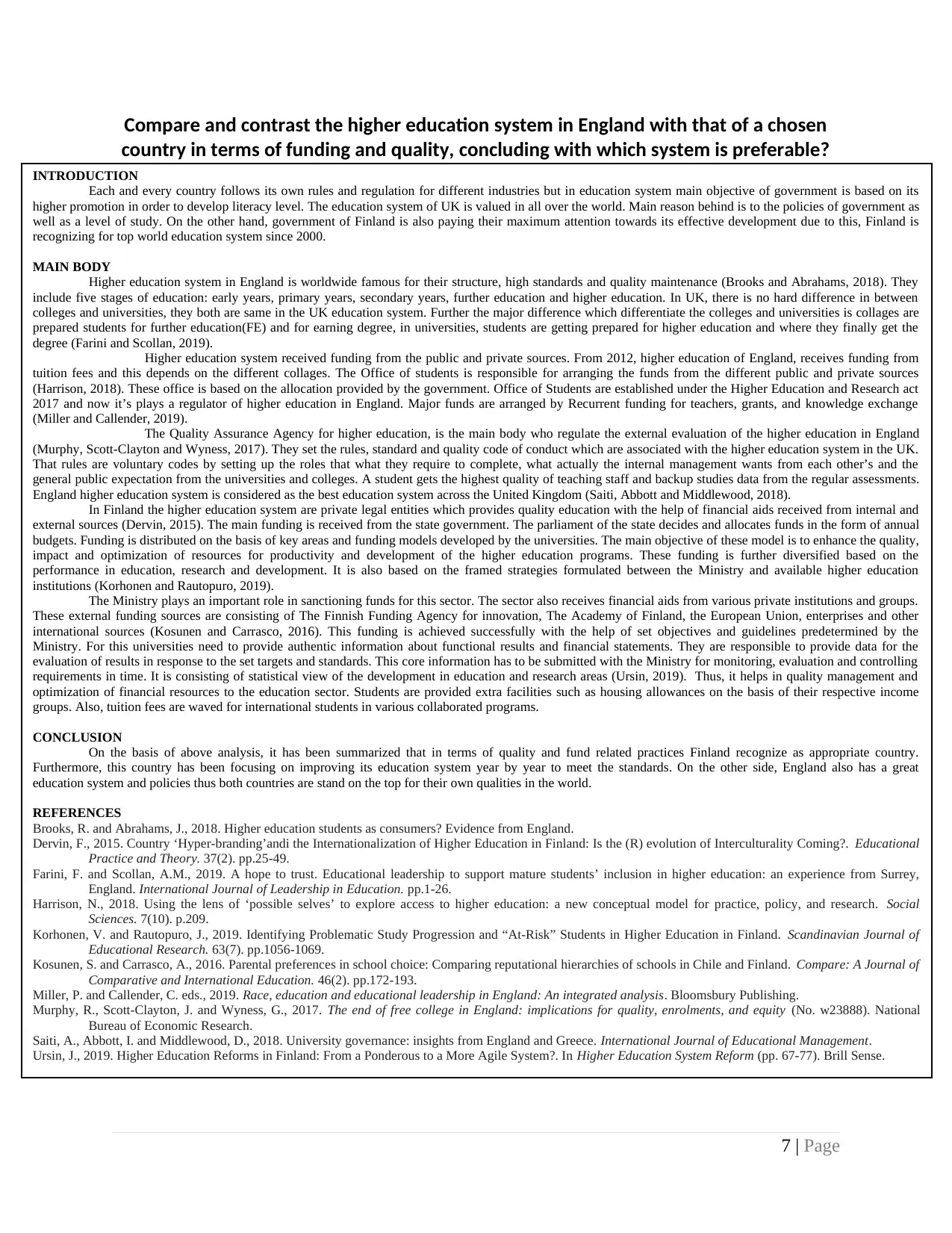
Compare and contrast the higher education system in England with that of a chosen
country in terms of funding and quality, concluding with which system is preferable?
7 | Page
INTRODUCTION
Each and every country follows its own rules and regulation for different industries but in education system main objective of government is based on its
higher promotion in order to develop literacy level. The education system of UK is valued in all over the world. Main reason behind is to the policies of government as
well as a level of study. On the other hand, government of Finland is also paying their maximum attention towards its effective development due to this, Finland is
recognizing for top world education system since 2000.
MAIN BODY
Higher education system in England is worldwide famous for their structure, high standards and quality maintenance (Brooks and Abrahams, 2018). They
include five stages of education: early years, primary years, secondary years, further education and higher education. In UK, there is no hard difference in between
colleges and universities, they both are same in the UK education system. Further the major difference which differentiate the colleges and universities is collages are
prepared students for further education(FE) and for earning degree, in universities, students are getting prepared for higher education and where they finally get the
degree (Farini and Scollan, 2019).
Higher education system received funding from the public and private sources. From 2012, higher education of England, receives funding from
tuition fees and this depends on the different collages. The Office of students is responsible for arranging the funds from the different public and private sources
(Harrison, 2018). These office is based on the allocation provided by the government. Office of Students are established under the Higher Education and Research act
2017 and now it’s plays a regulator of higher education in England. Major funds are arranged by Recurrent funding for teachers, grants, and knowledge exchange
(Miller and Callender, 2019).
The Quality Assurance Agency for higher education, is the main body who regulate the external evaluation of the higher education in England
(Murphy, Scott-Clayton and Wyness, 2017). They set the rules, standard and quality code of conduct which are associated with the higher education system in the UK.
That rules are voluntary codes by setting up the roles that what they require to complete, what actually the internal management wants from each other’s and the
general public expectation from the universities and colleges. A student gets the highest quality of teaching staff and backup studies data from the regular assessments.
England higher education system is considered as the best education system across the United Kingdom (Saiti, Abbott and Middlewood, 2018).
In Finland the higher education system are private legal entities which provides quality education with the help of financial aids received from internal and
external sources (Dervin, 2015). The main funding is received from the state government. The parliament of the state decides and allocates funds in the form of annual
budgets. Funding is distributed on the basis of key areas and funding models developed by the universities. The main objective of these model is to enhance the quality,
impact and optimization of resources for productivity and development of the higher education programs. These funding is further diversified based on the
performance in education, research and development. It is also based on the framed strategies formulated between the Ministry and available higher education
institutions (Korhonen and Rautopuro, 2019).
The Ministry plays an important role in sanctioning funds for this sector. The sector also receives financial aids from various private institutions and groups.
These external funding sources are consisting of The Finnish Funding Agency for innovation, The Academy of Finland, the European Union, enterprises and other
international sources (Kosunen and Carrasco, 2016). This funding is achieved successfully with the help of set objectives and guidelines predetermined by the
Ministry. For this universities need to provide authentic information about functional results and financial statements. They are responsible to provide data for the
evaluation of results in response to the set targets and standards. This core information has to be submitted with the Ministry for monitoring, evaluation and controlling
requirements in time. It is consisting of statistical view of the development in education and research areas (Ursin, 2019). Thus, it helps in quality management and
optimization of financial resources to the education sector. Students are provided extra facilities such as housing allowances on the basis of their respective income
groups. Also, tuition fees are waved for international students in various collaborated programs.
CONCLUSION
On the basis of above analysis, it has been summarized that in terms of quality and fund related practices Finland recognize as appropriate country.
Furthermore, this country has been focusing on improving its education system year by year to meet the standards. On the other side, England also has a great
education system and policies thus both countries are stand on the top for their own qualities in the world.
REFERENCES
Brooks, R. and Abrahams, J., 2018. Higher education students as consumers? Evidence from England.
Dervin, F., 2015. Country ‘Hyper-branding’andi the Internationalization of Higher Education in Finland: Is the (R) evolution of Interculturality Coming?. Educational
Practice and Theory. 37(2). pp.25-49.
Farini, F. and Scollan, A.M., 2019. A hope to trust. Educational leadership to support mature students’ inclusion in higher education: an experience from Surrey,
England. International Journal of Leadership in Education. pp.1-26.
Harrison, N., 2018. Using the lens of ‘possible selves’ to explore access to higher education: a new conceptual model for practice, policy, and research. Social
Sciences. 7(10). p.209.
Korhonen, V. and Rautopuro, J., 2019. Identifying Problematic Study Progression and “At-Risk” Students in Higher Education in Finland. Scandinavian Journal of
Educational Research. 63(7). pp.1056-1069.
Kosunen, S. and Carrasco, A., 2016. Parental preferences in school choice: Comparing reputational hierarchies of schools in Chile and Finland. Compare: A Journal of
Comparative and International Education. 46(2). pp.172-193.
Miller, P. and Callender, C. eds., 2019. Race, education and educational leadership in England: An integrated analysis. Bloomsbury Publishing.
Murphy, R., Scott-Clayton, J. and Wyness, G., 2017. The end of free college in England: implications for quality, enrolments, and equity (No. w23888). National
Bureau of Economic Research.
Saiti, A., Abbott, I. and Middlewood, D., 2018. University governance: insights from England and Greece. International Journal of Educational Management.
Ursin, J., 2019. Higher Education Reforms in Finland: From a Ponderous to a More Agile System?. In Higher Education System Reform (pp. 67-77). Brill Sense.
country in terms of funding and quality, concluding with which system is preferable?
7 | Page
INTRODUCTION
Each and every country follows its own rules and regulation for different industries but in education system main objective of government is based on its
higher promotion in order to develop literacy level. The education system of UK is valued in all over the world. Main reason behind is to the policies of government as
well as a level of study. On the other hand, government of Finland is also paying their maximum attention towards its effective development due to this, Finland is
recognizing for top world education system since 2000.
MAIN BODY
Higher education system in England is worldwide famous for their structure, high standards and quality maintenance (Brooks and Abrahams, 2018). They
include five stages of education: early years, primary years, secondary years, further education and higher education. In UK, there is no hard difference in between
colleges and universities, they both are same in the UK education system. Further the major difference which differentiate the colleges and universities is collages are
prepared students for further education(FE) and for earning degree, in universities, students are getting prepared for higher education and where they finally get the
degree (Farini and Scollan, 2019).
Higher education system received funding from the public and private sources. From 2012, higher education of England, receives funding from
tuition fees and this depends on the different collages. The Office of students is responsible for arranging the funds from the different public and private sources
(Harrison, 2018). These office is based on the allocation provided by the government. Office of Students are established under the Higher Education and Research act
2017 and now it’s plays a regulator of higher education in England. Major funds are arranged by Recurrent funding for teachers, grants, and knowledge exchange
(Miller and Callender, 2019).
The Quality Assurance Agency for higher education, is the main body who regulate the external evaluation of the higher education in England
(Murphy, Scott-Clayton and Wyness, 2017). They set the rules, standard and quality code of conduct which are associated with the higher education system in the UK.
That rules are voluntary codes by setting up the roles that what they require to complete, what actually the internal management wants from each other’s and the
general public expectation from the universities and colleges. A student gets the highest quality of teaching staff and backup studies data from the regular assessments.
England higher education system is considered as the best education system across the United Kingdom (Saiti, Abbott and Middlewood, 2018).
In Finland the higher education system are private legal entities which provides quality education with the help of financial aids received from internal and
external sources (Dervin, 2015). The main funding is received from the state government. The parliament of the state decides and allocates funds in the form of annual
budgets. Funding is distributed on the basis of key areas and funding models developed by the universities. The main objective of these model is to enhance the quality,
impact and optimization of resources for productivity and development of the higher education programs. These funding is further diversified based on the
performance in education, research and development. It is also based on the framed strategies formulated between the Ministry and available higher education
institutions (Korhonen and Rautopuro, 2019).
The Ministry plays an important role in sanctioning funds for this sector. The sector also receives financial aids from various private institutions and groups.
These external funding sources are consisting of The Finnish Funding Agency for innovation, The Academy of Finland, the European Union, enterprises and other
international sources (Kosunen and Carrasco, 2016). This funding is achieved successfully with the help of set objectives and guidelines predetermined by the
Ministry. For this universities need to provide authentic information about functional results and financial statements. They are responsible to provide data for the
evaluation of results in response to the set targets and standards. This core information has to be submitted with the Ministry for monitoring, evaluation and controlling
requirements in time. It is consisting of statistical view of the development in education and research areas (Ursin, 2019). Thus, it helps in quality management and
optimization of financial resources to the education sector. Students are provided extra facilities such as housing allowances on the basis of their respective income
groups. Also, tuition fees are waved for international students in various collaborated programs.
CONCLUSION
On the basis of above analysis, it has been summarized that in terms of quality and fund related practices Finland recognize as appropriate country.
Furthermore, this country has been focusing on improving its education system year by year to meet the standards. On the other side, England also has a great
education system and policies thus both countries are stand on the top for their own qualities in the world.
REFERENCES
Brooks, R. and Abrahams, J., 2018. Higher education students as consumers? Evidence from England.
Dervin, F., 2015. Country ‘Hyper-branding’andi the Internationalization of Higher Education in Finland: Is the (R) evolution of Interculturality Coming?. Educational
Practice and Theory. 37(2). pp.25-49.
Farini, F. and Scollan, A.M., 2019. A hope to trust. Educational leadership to support mature students’ inclusion in higher education: an experience from Surrey,
England. International Journal of Leadership in Education. pp.1-26.
Harrison, N., 2018. Using the lens of ‘possible selves’ to explore access to higher education: a new conceptual model for practice, policy, and research. Social
Sciences. 7(10). p.209.
Korhonen, V. and Rautopuro, J., 2019. Identifying Problematic Study Progression and “At-Risk” Students in Higher Education in Finland. Scandinavian Journal of
Educational Research. 63(7). pp.1056-1069.
Kosunen, S. and Carrasco, A., 2016. Parental preferences in school choice: Comparing reputational hierarchies of schools in Chile and Finland. Compare: A Journal of
Comparative and International Education. 46(2). pp.172-193.
Miller, P. and Callender, C. eds., 2019. Race, education and educational leadership in England: An integrated analysis. Bloomsbury Publishing.
Murphy, R., Scott-Clayton, J. and Wyness, G., 2017. The end of free college in England: implications for quality, enrolments, and equity (No. w23888). National
Bureau of Economic Research.
Saiti, A., Abbott, I. and Middlewood, D., 2018. University governance: insights from England and Greece. International Journal of Educational Management.
Ursin, J., 2019. Higher Education Reforms in Finland: From a Ponderous to a More Agile System?. In Higher Education System Reform (pp. 67-77). Brill Sense.
Paraphrase This Document
Need a fresh take? Get an instant paraphrase of this document with our AI Paraphraser

SECTION 6: Essay Self Assessment
Complete this form before you submit your portfolio.
Good Evidence Some Evidence Insufficient Evidence
Essay Structure
A. Has a clear structure
including an
introduction; body
paragraphs, conclusion
& bibliography
✔
B. Has a clear thesis
statement that states
their sub topics and
position
✔
C. Has clear topic
sentences in each main
body paragraph
✔
D. Has features of an
essay not a report, i.e. no
headings, bullet points
etc.
✔
Content
E. Has compared
directly between the two
countries in each
paragraph
✔
F. Has commented on
what we learn from the
comparisons
✔
G. Has included suitable
background information
in the introduction
✔
H. Has included a
suitable summary and
overall comment in the
conclusion
✔
I. Has written 750 words
(+/- 10%) ✔
Use of Sources and Referencing
J. Has a minimum of 2
sources per paragraph ✔
K. Has in-text citations
which follow Harvard
style. E.g. (Coughlan,
✔
8 | Page
Complete this form before you submit your portfolio.
Good Evidence Some Evidence Insufficient Evidence
Essay Structure
A. Has a clear structure
including an
introduction; body
paragraphs, conclusion
& bibliography
✔
B. Has a clear thesis
statement that states
their sub topics and
position
✔
C. Has clear topic
sentences in each main
body paragraph
✔
D. Has features of an
essay not a report, i.e. no
headings, bullet points
etc.
✔
Content
E. Has compared
directly between the two
countries in each
paragraph
✔
F. Has commented on
what we learn from the
comparisons
✔
G. Has included suitable
background information
in the introduction
✔
H. Has included a
suitable summary and
overall comment in the
conclusion
✔
I. Has written 750 words
(+/- 10%) ✔
Use of Sources and Referencing
J. Has a minimum of 2
sources per paragraph ✔
K. Has in-text citations
which follow Harvard
style. E.g. (Coughlan,
✔
8 | Page
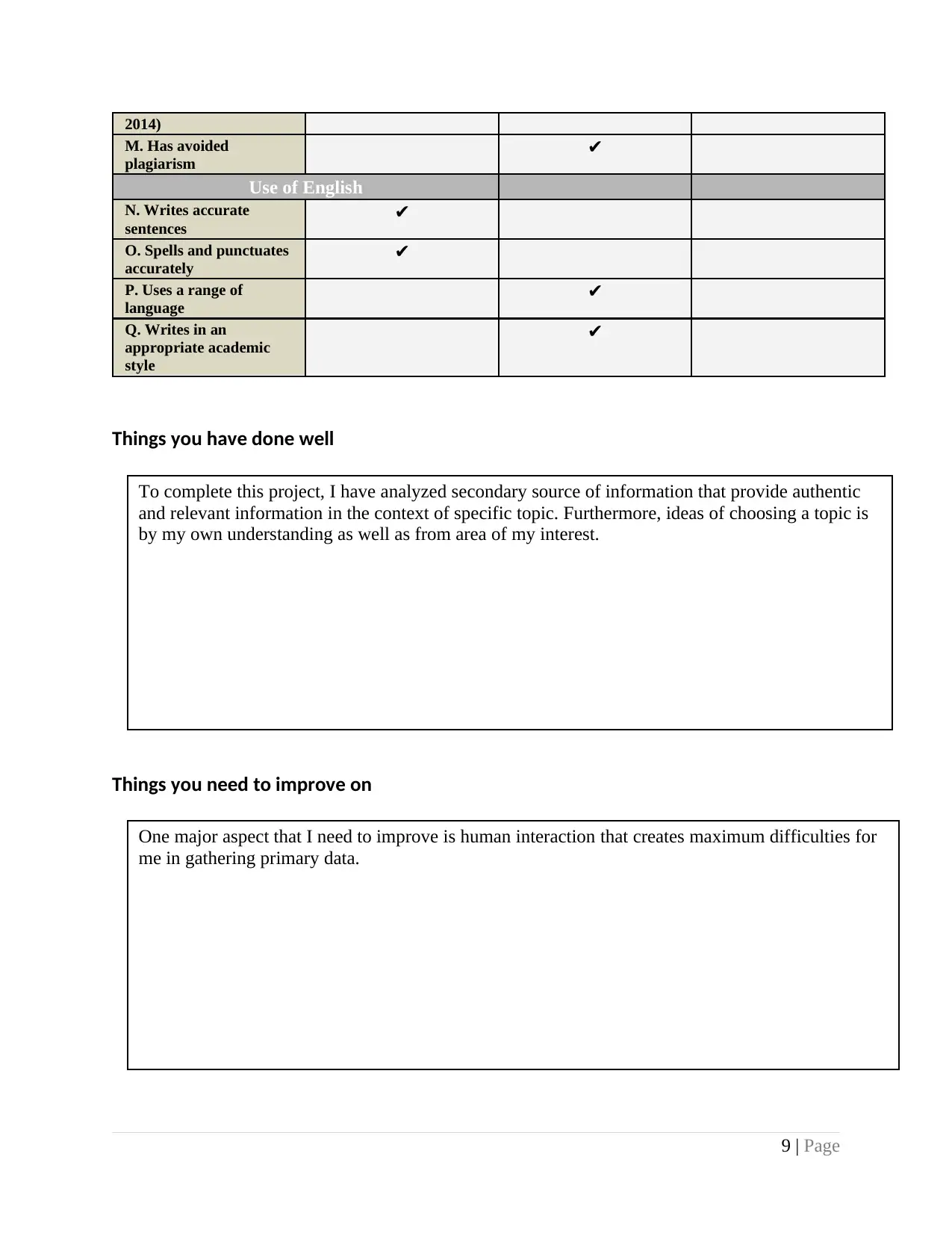
2014)
M. Has avoided
plagiarism ✔
Use of English
N. Writes accurate
sentences ✔
O. Spells and punctuates
accurately ✔
P. Uses a range of
language ✔
Q. Writes in an
appropriate academic
style
✔
Things you have done well
Things you need to improve on
9 | Page
To complete this project, I have analyzed secondary source of information that provide authentic
and relevant information in the context of specific topic. Furthermore, ideas of choosing a topic is
by my own understanding as well as from area of my interest.
One major aspect that I need to improve is human interaction that creates maximum difficulties for
me in gathering primary data.
M. Has avoided
plagiarism ✔
Use of English
N. Writes accurate
sentences ✔
O. Spells and punctuates
accurately ✔
P. Uses a range of
language ✔
Q. Writes in an
appropriate academic
style
✔
Things you have done well
Things you need to improve on
9 | Page
To complete this project, I have analyzed secondary source of information that provide authentic
and relevant information in the context of specific topic. Furthermore, ideas of choosing a topic is
by my own understanding as well as from area of my interest.
One major aspect that I need to improve is human interaction that creates maximum difficulties for
me in gathering primary data.
⊘ This is a preview!⊘
Do you want full access?
Subscribe today to unlock all pages.

Trusted by 1+ million students worldwide
1 out of 9
Related Documents
Your All-in-One AI-Powered Toolkit for Academic Success.
+13062052269
info@desklib.com
Available 24*7 on WhatsApp / Email
![[object Object]](/_next/static/media/star-bottom.7253800d.svg)
Unlock your academic potential
Copyright © 2020–2025 A2Z Services. All Rights Reserved. Developed and managed by ZUCOL.





